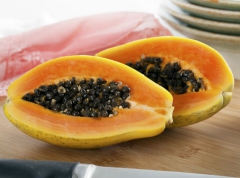11/18/2014
The rock 'n roll crib - Part 2
No problem, only solution! You call your Indian friend on holidays in Los Angeles; you have THE mini-crib delivered to her by Amazon (and you get ready to put the same amount in the luggage supplement as you have put in the cradle)! And just before making the transfer on the airline website, you ask her to take measurements, just to be sure... And boom, it is just above the maximum oversized dimensions... You still want to check if the airline would not adjust for a few inches here and there but obviously it’s midnight and the offices in India are closed. So your friend, some 15 time zones away, offers to call them in the US, only to be redirected to... a call center in India. Of course. In short, the Indian staff repeats word for word what is written on the site, and the parcel is returned to the sender. As for us, we go back to our local solutions.
Which boil down to two Mother Care cribs, 0-6 months (and the Indian rocking ones which are just ugly, either in plastic or metal). We visit the store for the first time – we are now less than two months away from delivery, it is never too late! – to see the last piece on sale. Then we visit a British friend in one of the most beautiful towers in Mumbai to check out the other model that she is selling as second hand. Both options seem acceptable to me – let’s make a decision, how much energy can we spend for a bed??
08:00 Posted in Expatriation (in India and in other countries), Incredible India!, Little Samourai, My stories in India | Permalink | Comments (0) | Tags: india, baby, crib, craddle, mini-crib | ![]() Facebook | |
Facebook | |
11/16/2014
The rock 'n roll crib - Part 1
Five months into pregnancy: shopping for baby – zero; shopping planned for baby – zero.
Except that sometimes you can’t remain ignorant despite your best efforts. So having tea with a friend who was in the last stage of pregnancy, I learned everything about co-sleeping (well… ‘everything’... I learned that co-sleeping means that the baby is sleeping in your bed, or almost). I quite liked her idea of a baby bed stuck to the parents’ bed, as a fit solution for lazy me: no need to get out of bed to feed during the night!
That same evening I naturally brought up the topic with my favorite Indian who managed to remain completely impassive, not at all surprised the guy. His mother, on the other hand... Culture gap: in India the baby sleeps in the parental bed until he is at least two; in France he is sent in exile to his room on the first night (we teach them life immediately, no sympathy!). Hence the (rather vehement) look of disapproval on my mother’s face when I mentioned co-sleeping!
Argument in favor of the Indian tradition: practical and economical. Argument against: what about couple intimacy? The whole family concept reflects in this sleeping habit... In India the family revolves around children and parents. In France (not to say in the West), it revolves around the couple. In short. (This is why when the couple goes down the drain, so does the family...)
As in life everything is a matter of compromise, we agreed quickly (my main argument (regarding our sex life – I do hope to resume it before Junior is 5 (and I am not ashamed of it)) seems to have struck a chord) on a cradle that would be near the bed (but not stuck to it), which would be moved after 3-6 months (we keep some room!) in the guest bedroom – I would like to call it the baby’s room but really, we did zero arrangement!
So this sleeping option seemed flexible... Flexible but not simple. In a country where babies sleep in their parents’ bed or in pieces of fabric hanging from a rope as hammocks, it is definitely not easy to find a crib. And then, surprise, your dear husband looks into the issue in depth and come out an expert in cribs. So after he explained the benefits of gliding versus rocking, of strengthened protection to avoid the baby eating wood when chewing his bars and elected the cradle of his dreams (the perfect bed that goes from 0 to 24 months, which rocks but can also roll) you have to buy it right?? Except that the ‘Da Vinci rocking mini-crib’ is not sold in India. Not even in France. Actually it is nowhere to be found but in North America. And without any possible delivery to other countries. So what do you do then eh? How to reward such an amazing male involvement??
08:00 Posted in Expatriation (in India and in other countries), Incredible India!, Little Samourai, My stories in India | Permalink | Comments (0) | Tags: india, baby, crib, craddle, mini-crib | ![]() Facebook | |
Facebook | |
11/06/2014
Pregnancy advice, Indian style
At 6 weeks, my Indian gynaecologist (a dinosaur) confirmed the pregnancy and provided her first recommendations: “You immediately stop papaya. And also pineapple. Also you stop outside food for the next 6 weeks.”
 Not that I eat papaya everyday but I don’t like being told I can’t do things! So I checked… There was only a study, conducted on rats, and here is what is says: “The results suggest that normal consumption of ripe papaya during pregnancy may not pose any significant danger. However, the unripe or semi-ripe papaya (which contains high concentration of the latex that produces marked uterine contractions) could be unsafe in pregnancy.” (source). As my new doctor puts it, you need to it kilos of papaya to maybe feel an effect, nothing to panic about after eating a slice at breakfast!
Not that I eat papaya everyday but I don’t like being told I can’t do things! So I checked… There was only a study, conducted on rats, and here is what is says: “The results suggest that normal consumption of ripe papaya during pregnancy may not pose any significant danger. However, the unripe or semi-ripe papaya (which contains high concentration of the latex that produces marked uterine contractions) could be unsafe in pregnancy.” (source). As my new doctor puts it, you need to it kilos of papaya to maybe feel an effect, nothing to panic about after eating a slice at breakfast!
 Then I informed my stock manager about the pregnancy and his first question was whether I had hanged a poster of cute babies on the wall? He was convinced of the method because he had hanged a poster of white babies and his daughter was of fair complexion! Careful not to have a Smurf pic on the wall!! When I laughed about it (in spite having seen a similar poster on my sister-in-law’s wall) I was told that having “having good looking or positive pictures on the wall can surely make me feel good which is great for overall pregnancy and well-being”. Later on, in the same vein, my favourite Indian asked me to read less thrillers and stop watching murder movies… Happy puppy will give birth to happy puppies!
Then I informed my stock manager about the pregnancy and his first question was whether I had hanged a poster of cute babies on the wall? He was convinced of the method because he had hanged a poster of white babies and his daughter was of fair complexion! Careful not to have a Smurf pic on the wall!! When I laughed about it (in spite having seen a similar poster on my sister-in-law’s wall) I was told that having “having good looking or positive pictures on the wall can surely make me feel good which is great for overall pregnancy and well-being”. Later on, in the same vein, my favourite Indian asked me to read less thrillers and stop watching murder movies… Happy puppy will give birth to happy puppies!
A few weeks later, I visited a customer and her reaction was very spontaneous: “Oh you look even more beautiful! When is your baby girl due??” Seeing my face – how could she possibly have an information (the gender) that I didn’t?? – she explained that a glow on the face indicates you will deliver a baby girl. But glowing me also has a low, small and round belly, which would indicate a boy. So let’s see!
At work, I also get “healthy” advice: “you need to eat double as you eat for two”, “don’t take the stairs it may create a shock for the baby”, “what??? You are traveling by rickshaw, stop immediately! And by bike also, are you nuts??”. No wonder a lot of pregnant Indian women turn into elephants – which is the favourite topic of my new gynaecologist: the wonder of Indian mothers’ transformation during pregnancy versus Western women – her theory is that it has to be genetic. Which I am not convinced about since studies (source) state that “women in Western Europe gain 10-12 kg in weight compared with their counterparts in the developing world [India being included in the study] where the average weight gain is 7-9 kg”. Anyhow, she still shows no compassion when I put on an extra 100 gms!
I was not given the following advice but I found it very funny: “Drinking coconut water after the seventh month of pregnancy makes the baby’s head as large as the coconut.” Or “eating something white first thing in the morning will result in a fair-skinned baby.”
And, last but not least, when discussing these Indian myth with a French friend, she shared, roaring with laughter, that she had read that in villages, pregnant women eat ghee (clarified butter (pure butterfat left over after the milk solids and water are removed from butter) commonly used in Indian cooking) to lubricate the way out of the baby. I also found it very funny till the day my favourite Indian came home with ‘my’ ghee. And no, I didn’t laugh at his face because when he came home in the first trimester with my ‘tea’ (a disgusting ayurvedic potion called ‘Bhadradi Kashayam’) he practically saved my life and helped me overcome nausea all through the pregnancy. Plus he had taken up on him to give me a healthy diet and made salads, soups, juice etc. every day. So the minimum I could do was to take him seriously and do some research. I was not supposed to eat cooking ghee but a special ‘herbal’ ghee, like he has one for his joints (depending on the herbs, the ghee will deposit in different parts of the body). And not astronomical quantities like I had been told (which was to ruin all our efforts for me not to put on too much weight). So I have been taking one spoon daily of ‘Sukhaprasava Ghritham’. It is given in 7th and 8th month of pregnancy to ensure easy delivery of child.
Sources (pregnancy myths in India): http://www.babycenter.in/x1023025/is-it-safe-to-eat-papaya-ipapitai-during-pregnancy ;
http://www.thehealthsite.com/pregnancy/eating-ghee-will-make-your-baby-slide-out-easier-and-other-such-hilarious-indian-myths-busted/; http://wonderwoman.intoday.in/story/food-myths-in-pregnancy/1/84211.html ; http://www.rediff.com/getahead/2007/may/23preg.htm
Sources (Ayurveda and pregnancy): http://www.ayurvedaelements.com/articledivinedelivery.php ; http://ayurveda-foryou.com/women/garbhasanskar.html ; http://ayurmedinfo.com/2012/05/28/sukhaprasava-ghritham-benefits-dosage-side-effects-ingredients/
08:02 Posted in Expatriation (in India and in other countries), Incredible India!, Little Samourai, My stories in India | Permalink | Comments (0) | Tags: india, pregnancy, advice, myth, papaya, ghee | ![]() Facebook | |
Facebook | |















